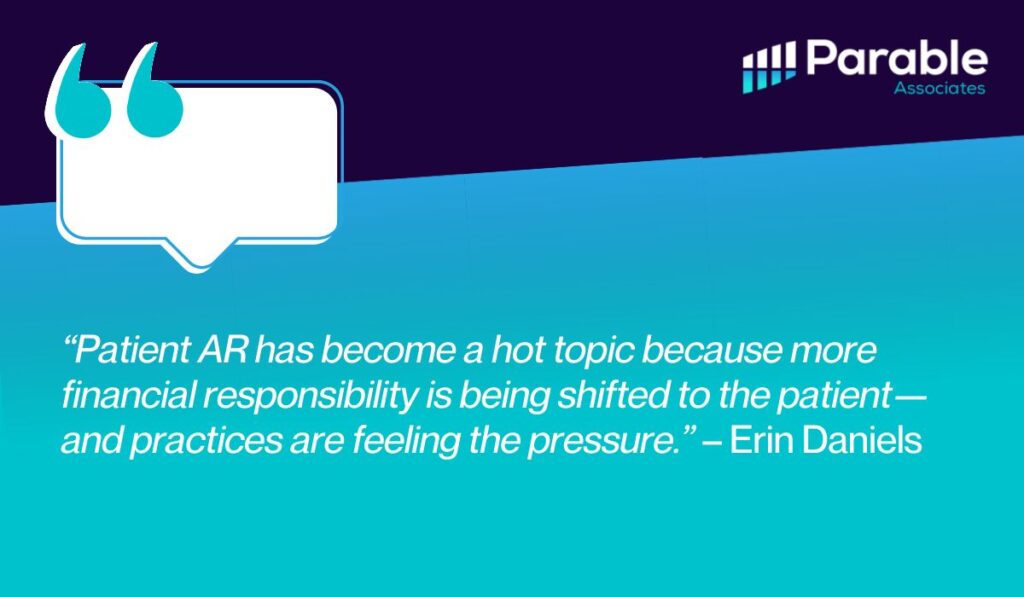Patient Accounts Receivable - Accelerating The Revenue Cycle
Patient accounts receivable (patient AR) is critical to a healthcare practice’s revenue cycle. It represents the outstanding balances owed by patients after insurance payments and adjustments. Efficient management of these receivables ensures steady cash flow, reduces financial risk, and strengthens the financial health of a medical practice. With the rise of high-deductible health plans, patient financial responsibility has increased significantly, making it even more crucial for practices to optimize their revenue cycle processes. Understanding the key challenges and implementing best practices can help practices accelerate collections, minimize bad debt, and improve financial performance.
Read on to learn more about the impact of patient accounts receivable on your revenue cycle and how to minimize that impact.
The Growing Challenge of Patient Accounts Receivable
The landscape of patient financial responsibility has changed dramatically over the years. Previously, copays and deductibles were relatively low, typically ranging from $300 to $500, making it easier for patients to afford medical bills. Today, high-deductible health plans require patients to pay thousands of dollars out of pocket before insurance coverage kicks in. As a result, many medical practices struggle with delayed payments, outstanding balances, and collection inefficiencies.

Unlike insurance claims processing, which follows structured workflows with payers, patient accounts receivable management presents unique challenges. Patients often delay payments due to financial constraints, confusion over their bills, or a lack of clear payment policies. Without a proactive strategy, practices risk accumulating unpaid balances, negatively impacting cash flow and overall revenue cycle efficiency.
Key Challenges: Patient AR Management
Delayed Billing and Payment Cycles
A common inefficiency in patient accounts receivable management is the delay between providing a service and receiving payment. The billing cycle typically involves claim submission, insurance adjudication, and patient billing. By the time patients receive their final statement, weeks or months may have passed, increasing the likelihood of delayed or missed payments.
Strategies for Improvement:
- Implement real-time eligibility verification to provide accurate patient responsibility estimates upfront.
- Collect copays and any outstanding patient balances at the time of service to reduce outstanding balances at the time of service to reduce outstanding balances.
- Use automated billing systems to ensure timely claim submissions and minimize processing delays.

Point-of-Service Collections Gaps
Many practices struggle to collect payments at the point of service, due to inefficient workflows or staff discomfort in discussing financial obligations with patients. Without a structured collection process, balances can quickly accumulate, leading to higher patient accounts receivable and increased write-offs.
Strategies for Improvement:
- Train front-desk staff on best practices for requesting payments at check-in and check-out.
- The front desk should be set up so that staff are equipped with all the resources necessary to facilitate the check-in process and collection of payments.
- Use scripting techniques to ensure staff confidently communicate patient financial expectations.
- Offer multiple payment options, including credit card processing, digital wallets, and payment plans.
Inconsistent Payment Posting and Reconciliation
Another significant challenge is ensuring that payments collected at the time of service are accurately posted promptly to the correct patient account. If payments are not applied correctly, it can lead to discrepancies, confusion, and additional administrative burdens.
Strategies for Improvement:
- Utilize practice management software to automatically post payments and reconcile accounts.
- Regularly audit payment records to ensure accuracy and prevent misallocations.
- Establish clear workflows for payment processing to increase efficiency and reduce manual errors.
Lack of Proactive Follow-Up on Outstanding Balances
Many practices fail to monitor outstanding patient balances effectively, leading to prolonged payment cycles and increased bad debt. Patient payment obligations can be overlooked or forgotten without a structured system to follow up on them.
Strategies for Improvement:
- Implement automated reminders via email, text, or phone calls to notify patients of upcoming due dates.
- Establish a structured collections policy that includes follow-up intervals and escalation procedures.
- Make sure all staff understand the collection policy and what the steps are as patient AR ages.
- Monitor aging reports to identify overdue accounts and take timely action.

Inefficient Statement Processing
Traditional paper statements are slow, costly, and often ineffective. Patients may misplace or ignore mailed bills, further delaying payments.
Strategies for Improvement:
- Transition to digital billing systems that allow patients to receive and pay bills online.
- Enable text-to-pay and email reminders to increase patient engagement.
- Offer secure patient portals where individuals can view and pay outstanding balances in real time.
Improve Patient AR Management with Business Intelligence
Business intelligence (BI) solutions play a crucial role in optimizing patient accounts receivable. By leveraging data analytics, automation, and predictive modeling, practices can streamline collections, reduce outstanding balances, and accelerate revenue cycles.
Enhance Payment Transparency and Upfront Collections
BI tools help practices assess patient financial responsibility in real time, enabling staff to discuss and collect payments before services are rendered. By analyzing historical billing data, practices can identify trends in patient payments and adjust policies accordingly.
Automate and Track Payment Posting
RPA posting bots streamline practice management systems by automating repetitive processes such as data entry, payment reconciliation, and claim processing. This automation enhances accuracy, accelerates payment posting, and improves overall efficiency in healthcare revenue cycle management. BI dashboards provide real-time insights into cash flow, allowing administrators to monitor collection rates and quickly identify discrepancies.

Improve Follow-Up Strategies with Predictive Analytics
Leveraging data analytics in medical billing significantly enhances precision and minimizes errors. By using predictive analytics, healthcare providers can analyze historical billing trends and detect potential issues before they lead to claim denials. This proactive approach reduces errors and streamlines the billing process, improving financial outcomes.
Optimize Statement Processing and Payment Methods
BI solutions offer insights into patient payment preferences, helping practices optimize their billing strategies. Practices can track which payment methods yield the highest success rates and adjust their approaches to maximize efficiency. Additionally, payment management systems (PMS) or merchant services offer convenient text-to-pay and digital billing options that improve collection rates.
Identify and Reduce Bad Debt
By analyzing patient accounts receivable trends, BI tools help practices determine which accounts are at risk of becoming uncollectible. With this information, administrators can implement early intervention strategies, such as setting up payment plans or offering financial counseling, to prevent revenue loss.
Ready to Accelerate Patient AR for Revenue Cycle Success?
Efficient patient accounts receivable management is essential for maintaining a healthy revenue cycle and ensuring the long-term financial success of a healthcare practice. However, managing patient AR effectively requires the right strategies, technology, and expertise.
Parable Associates specializes in helping healthcare practices optimize their revenue cycle by leveraging data-driven solutions. Our tailored BI strategies empower practices to:
- Improve patient payment collections and reduce outstanding balances.
- Implement automation tools for seamless payment posting and reconciliation.
- Develop proactive follow-up strategies to minimize bad debt.
- Enhance financial transparency with real-time reporting and analytics.
If your practice is struggling with high patient accounts receivable and looking for innovative solutions to accelerate cash flow, contact Parable Associates today. Let us help you streamline your revenue cycle, improve collections, and build a more financially sustainable practice.
Patient Accounts Receivable FAQs
Patient accounts receivable refers to the outstanding balances owed by patients for medical services after insurance payments and adjustments. Efficient management ensures steady cash flow and financial stability for healthcare practices.
Unlike insurance claims, which follow structured workflows, patient payments often face delays due to high deductibles, financial constraints, and lack of clear payment policies, increasing the risk of bad debt.
With deductibles reaching thousands of dollars, patients are responsible for more out-of-pocket costs, leading to delayed payments, increased outstanding balances, and financial strain on healthcare practices.
Key inefficiencies include delayed billing cycles, low point-of-service collections, payment posting errors, lack of follow-up on outstanding balances, and inefficient statement processing.
Practices should train front-desk staff to request payments at check-in, use automated eligibility verification, offer multiple payment options, and implement saved credit card policies for seamless transactions.
BI solutions provide real-time analytics, predict payment trends, and optimize follow-up strategies to reduce outstanding balances and improve cash flow.
Yes, automated billing ensures timely claim submissions, sends reminders for due payments, and enables digital payment options like text-to-pay and online portals, reducing reliance on slow, paper-based statements.
Practices can reduce bad debt by proactively identifying high-risk accounts, offering payment plans, improving financial transparency, and leveraging BI tools to analyze payment behaviors.
Predictive analytics help practices identify patients at risk of delayed payments, allowing for targeted follow-ups, customized payment reminders, and early intervention strategies.
Parable Associates provides data-driven solutions, automating AR processes, improving collection efficiency, and enhancing financial transparency to help practices accelerate cash flow and optimize their revenue cycle.


